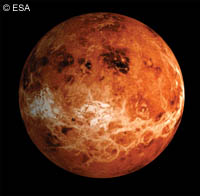Venus Express meets its target
The European Space Agency's (ESA) Venus Express probe has successfully gone into orbit around its target - the Earth's 'sister planet' Venus - after a five month journey of 415 million km. The probe was tracked right up to the point where it met the Venusian atmosphere and began a 50-minute engine burn to slow the probe and place it into position in the Venusian atmosphere. There then followed a tense ten minutes as the probe orbited the roasting planet, occultating the probe. This point is the most critical in the mission, as small errors in the height or velocity could result in the probe flying off course or even crashing. Happily, the probe re-established contact with the ground crew at 09:57 Central European Summer Time on Tuesday 11 April. This confirmed that the probe is moving as expected, and the mission now has a high probability of success. The probe will now regulate its orbit, which will be stable and ready to begin work in June. Venus is thought to contain many clues as to the development of the Earth. Venus is of a similar size to the Earth, although closer to the sun, but within the zone scientists consider suitable for life to develop. The planet has a substantially different mix of gases in its atmosphere, and this could provide important information relating to global warming on Earth. Venus has pressure around 100 times that of the Earth, and because it rotates so slowly, a year on Venus is slightly shorter than a day on Venus. 'Our prime objective is to study the processes that are going on inside Venus' atmosphere, ESA's head of planetary missions, Gerhard Schwehm, told the BBC. 'Nearly all the instruments give us information on either the composition of the atmosphere, temperature profile, or circulation. We want to see how the system works there because there are still many mysteries about Venus.' While the temperature on Earth allows the 'triple point' of water - where water is solid, liquid and gas - Venus has a temperature of some 450 degrees centigrade and clouds of dense carbon dioxide and sulphuric acid. But what puzzles scientists is how this happened. Although Venus is closer to the sun, the difference in energy absorption between this planet and the Earth is small. The obvious candidate is carbon dioxide. Professor Fred Taylor from Oxford University is a key advisor to the Venus Express team, and he believes that, 'On Earth, carbon dioxide is absorbed by the oceans, where it forms carbonate minerals and over the millennia is deposited as rock. That process was arrested early on Venus when it lost its oceans,' he told the Guardian newspaper. Although a great deal is known about Venus, the facts are not clear. For example, Venus has volcanoes, but it is not known whether they are active or whether they resemble the volcanoes on Earth. Part of this problem is that Venus has a thick cloud covering, obscuring much of the detail. The Venus Express will cut through this cloud by peering into 'spectroscopic windows' in the cloud, enabling a vastly improved understanding of our fiery neighbour. The arrival of the Venus probe marks a high-point for ESA, with a string of recent and spectacular successes under its belt, including the SMART-1 moon probe, the Mars explorer, which will keep scientists happy for years with the mountains of data it has sent back, and the Huygens probe, which sent back staggering pictures of Saturn's moon Titan last year. The Venus Explorer also marks a phenomenal turnaround for ESA - the probe was conceived, built and deployed in only five years.



